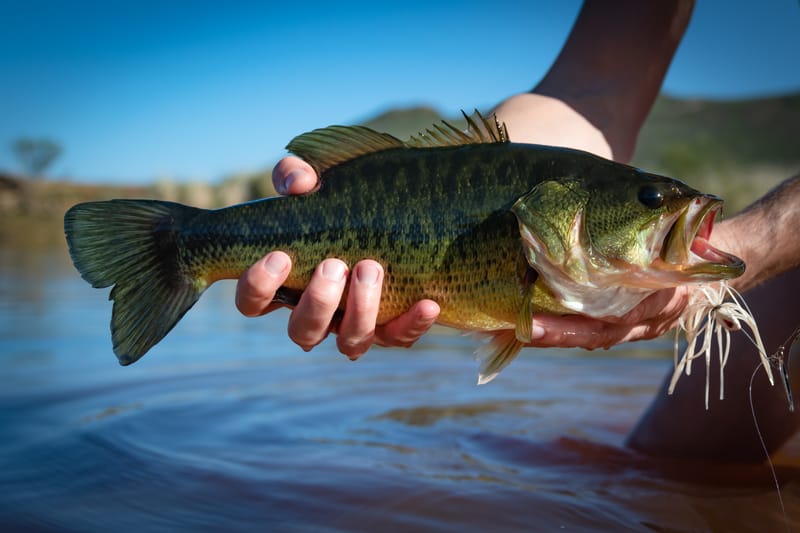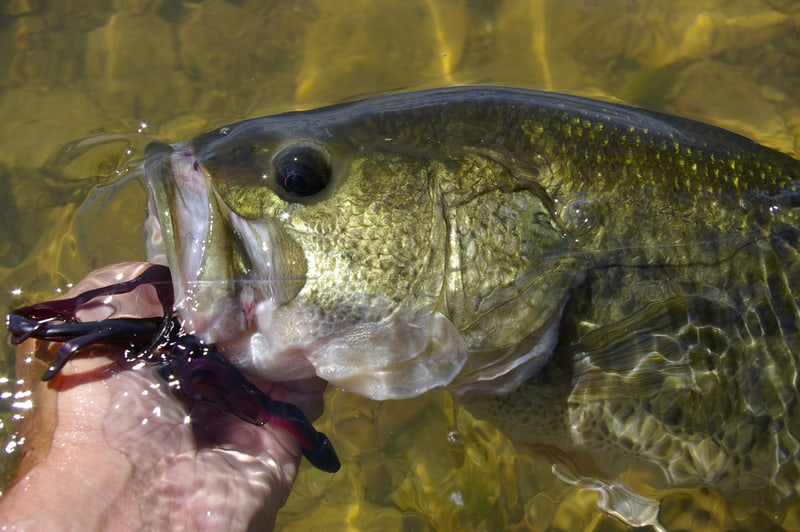Largemouth and Smallmouth Bass are both members of the Black Bass family. According to the U.S Census Bureau, Black bass are the most popular freshwater gamefish in North America. Among anglers, Large Mouth and Smallmouth Bass are two of the most preferred members of the Black Bass family due to their aggressive nature and willingness to fight hard once they’re on the hook. In areas where the two species overlap, they are similar enough to be difficult for a novice fisherman to distinguish between the two. There are some fundamental differences between large and smallmouth bass, though. They are as follows.
- Mouths-Largemouth Bass have oversized mouths designed to gulp down extra large prey. The upper jaw of a largemouth bass extends back behind their eye. The upper jaw of a small mouth ends before intersecting the line of the eye.
- Coloration-In general, Largemouths are green while small mouths are brown. There are color variations.. Again though, most of the time they are distinguishable by following the general rule that Largemouths are green and Smallmouths are brown.
- Lateral and horizontal lines- The lines on a Smallmouth Bass run laterally or from up near their backbones down towards their stomachs. The lines on Largemouths resemble connected splotches and run horizontally along the fish’s body.
- Dorsal Fins- A fish’s dorsal fins is the one that rise up from the middle their back. black Bas species have double dorsal fins, There’s a prominent separation between the two dorsal fins of a Largemouth Bass. On the other hand, Smallmouths have connected dorsal fins.
- Size- On average Largemouths are the bigger of the two species. The world record Smallmouth weighed 11 pounds, 15 ounces On the other hand, the world record Largemouth weighed in at 22 pounds 4 ounces.
- Fighting Will And Ability-Although both species are very aggressive on the strike and hard fighters on the hook, Smallmouths fight harder than Largemouths. Smallmouths jump out of the water over and over again trying to throw the hook while Largemouths generally don’t jump more than once.

Taxonomic Classification Of Largemouth Bass
- Kingdom- Animalia
- Phylum -Chordata
- Class-Actinopterygii
- Order – Perciformes
- Family – Centrarchidae
- Genus- Micropterus
- Species -Micropterus salmoides
Other names for Large Mouth Bass are as follows. According to different regions, Black Bass, Bucket mouth, Gilsdorf Bass, Green Trout, Green Bass, Oswego Bass, and Potter’s fish.

Where Do Largemouth Bass Live ?
Largemouth bass are native to St. Lawrence and Great Lakes, Hudson Bay (Red River), and the Mississippi River. On a wider scale, their native distribution also extends to the Atlantic Slope water flow from North Carolina to Florida and the Gulf Slope waters from southern Florida into northern Mexico. People have transplanted them extensively into other areas.
There are two different strains of Large Mouth Bass, Northern and Florida. Florida Large Mouths attain larger sizes than do Northern ones. Florida Largemouths are only native to the Florida peninsula. However, they’ve been transplanted into other southern states.

Taxonomic Classification Of Smallmouth Bass
- Kingdom- Animalia
- Phylum-Chordata
- Class-Actinopterygii
- Order- Perciformes
- Family- Centrarchidae
- Genus- Micropterus
- Species- Micropterus dolomieui
Where do Smallmouth Bass live?
Smallmouth bass are native to The Ohio River system, the upper Mississippi River, the Great Lakes, and the lower Missouri River and its tributaries. They’re a popular gamefish; consequently, people have transplanted them extensively.
Large and Smallmouth Bass are both members of the Centrarchidae family. The Centrarchidae family is made up of Ray-Finned Sun Fishes. Furthermore, they belong to the Micropterus genus. Members of the Micropterus genus are the Black Bass. Other Black Bass include Spotted Bass, Redeye Bass, Guadalupe Bass, and Suwannee Bass.
What Kind Of Habitat Do Largemouth Bass Prefer ?
Largemouth Bass live in clear vegetated still or slow-moving water such as lakes, ponds, and backwater sloughs on slow-moving rivers. They prefer water in the range of 80 to 90 degrees Fahrenheit. Northern Largemouths can tolerate water temperatures down into the 60s.
What Kind Of Habitat Do Smallmouth Bass Prefer?
First of all, Smallmouths need cooler, more oxygenated water than Largemouths do. They live in the clear shallow parts of deep reservoirs. They also live in cool faster flowing streams and lakes and reservoirs fed by these streams.
Where Are Some Of The Best Bass Fishing Spots In The United States?
Some specific spots to fish for bass are highlighted below.
Largemouth
- Lake Kissimmee Florida
- Falcon Lake and Toledo Bend, Texas
- Guntersville Lake, and Wheeler Lake, Alabama
- Toledo Bend Reservoir, Louisiana
- Lake Barkley and Kentucky Lake, Kentucky
- Clear Lake, California
- Reelfoot Lake and Lake Chickamauga, Tennessee
Smallmouth
- Susquehanna River and Juniata River Pennsylvania
- Dale Hollow Reservoir and Kentucky Lake Kentucky
- Lake Powell and Flaming Gorge Reservoir Utah
- Missouri River and Lake Sakakawea North Dakota
- Lake Mille Lacs and Lake Pokegama Minnesota
- The Delaware River and Lake Erie New York
- Lake Grand Stream Maine
Are Largemouth Bass Good To Eat ?
Largemouth bass are popular among anglers because of their wide availability and their excellent gamefish characteristics. On the other hand, their reputation as something to have for dinner isn’t quite as good. Because of their habitat and diet, the taste of their meat might be slightly swampy or fishy, which some people might not prefer. However, largemouth bass is absolutely great table fare when processed and treated right and makes for a delicious meal.
To be more detailed, the largemouth bass has white meat with a firm bite and slightly tender flesh. As mentioned before, their diet renders a fishy smell and meatier texture to their flesh. Regardless, like most fish, this species is an excellent source of nutrients packed with protein and essential minerals and low in saturated fat.
Are Smallmouth Bass Good To Eat?
Neither Largemouth nor Smallmouth Bass are all that popular for quality eating. However, of the two species, Smallmouths have the edge as an eating fish. Because they live in a cooler, cleaner environment, their meat has a sweeter taste most of the time, whereas Largemouths are fishier.
How To Fillet A Bass
Filleting a bass fish is similar to prepping other kinds of fish. See filleting Channel Catfish. This same process will work equally well for Large and Smallmouth Bass.
With a sharp fillet knife, slice directly behind the pectoral fin and gills until you reach the spine. You then turn the knife and slice along the spine and the ribs towards the tail from the top of the fish. When you pass the rib cage and are in the tail area, push the tip of the knife all the way through and out the bottom of the fish, then proceed to slice all the way back almost to the tail fin.
Now return to the first cut you made behind the gills, insert your thumb and proceed to peel your fillet down and back from the ribs while slicing with your fillet knife. You’ll need to peel and slice all the way down to the belly meat of the fish. Now detach your fillet. You’ll next flip the fish over and repeat the same process to get your second fillet.
To remove the skin from your fillets, first, place a fillet skin side down on a cutting board with the tail end facing you. The next step is to make a small cut through the meat on the very tail end down to but not through the skin. Next, insert your filleting knife through the cut, turn it parallel to the skin and slice it along between the fillet and the skin until the fillet is detached.
How To Cook Bass
Bass meat is very flexible to cook and can accommodate various recipes. Like most fish, they can be fried, grilled, and baked.
Deep Fried Bass Recipe
- 1 Tbsp. Lemon Pepper
- 2 tsp Onion powder
- 1Tbsp salt
- 1 tsp Cayenne Pepper
- 1 1/2 Corn Meal
- 2 tsp Salt
- 1 c Milk or Butter Milk
- 6 Bass fillets·
- oil for deep frying
- Heat a deep fryer to 375 degrees. Mix the cornmeal, garlic powder, onion powder, cayenne, paprika and salt together in a shallow dish
- Place the milk in a separate shallow dish. Dredge the fish fillets in the milk then roll in the dry ingredient mixture. Deep fry for about 5 min.
Recent Posts
The only venomous snakes in Washington State are Northern Pacific Rattlesnakes. The Northern Pacific Rattlesnake (Crotalus oreganus oreganus) is a sub-species of the Western Rattlesnake. Anyone...
Skunks are not classified as true hibernators. But they go into a state of torpor when the weather gets cold. Skunks are light sleep hibernators, along with opossums, bears, and raccoons. ...

